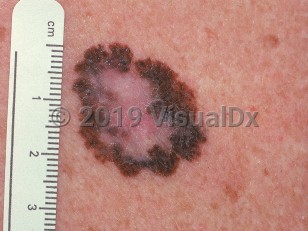Melanoma in Child
See also in: Anogenital,Hair and Scalp,Oral Mucosal LesionAlerts and Notices
Important News & Links
Synopsis

The etiology of melanoma is incompletely understood, although ultraviolet radiation is believed to play a role in some melanomas and knowledge of the melanoma genome continues to advance. Melanoma susceptibility genes have been associated with melanoma tumor syndromes and some other familial tumor syndromes; these include mutations in CDKN2A/CDK4 (familial atypical multiple mole melanoma syndrome [FAMMM syndrome]), BAP1 (BAP1 cancer syndrome), MITF (MITF tumor syndrome), TERT/Shelterin complex, and PTEN). Melanoma has been shown to have one of the highest mutation rates of any cancer type, reflective of its clinical and pathologic diversity and resistance to treatment in advanced stages.
Predisposing conditions for melanoma in children include giant congenital melanocytic nevi, dysplastic nevus syndromes, xeroderma pigmentosum, and immunodeficiency states (either inherited or iatrogenic). While a family history of melanoma, a history of severe sunburns, multiple atypical nevi, the inability to tan, or red hair color are predisposing conditions to adult melanoma, the relevance to development of childhood melanoma is unknown. Approximately 30% of pediatric melanomas arise from giant congenital nevi, while another 50% arise de novo.
It has been noted in the literature that the ABCD criteria (asymmetry, border irregularity, color variegation, diameter > 6 mm) for diagnosis of melanoma in adults are often absent in melanomas arising in the pediatric population, especially in children aged 10 years and younger. The absence of these features may contribute to delay in diagnosis of melanoma in this age group. ABCD criteria specific to the pediatric population have been proposed:
A: Amelanotic – Many pediatric melanomas are pink, red, or skin-colored. Some resemble warts or lobular capillary hemangiomas (pyogenic granulomas).
B: Bleeding, Bump (papule or nodule)
C: Color uniformity (rather than variegation)
D: De novo, any Diameter
The "E" of the ABCDE criteria in adults (evolution) applies to melanoma in this age group.
It is recommended that both sets of ABCD criteria be employed to improve early detection of pediatric melanoma.
In a review comparing pediatric melanoma with adult melanoma, it was found that pediatric patients often have a thicker depth of invasion at the time of diagnosis as well as a higher incidence of positive lymph node metastasis. Interestingly, however, there was no statistical difference in the 5-year and 10-year survival between the 2 groups. Further study of thickness as a prognostic factor, and other prognostic factors in childhood melanoma, is warranted. A 2018 review comparing melanoma in 12 children (less than 11 years of age) and 20 adolescents (aged 11 to 19) found that more childhood melanomas were of the spitzoid subtype and that 4 deaths from melanoma occurred in the adolescent group, suggesting that there is heterogeneity among melanomas depending on age and that adolescent melanoma may behave more aggressively than that in children.
Related topic: amelanotic melanoma
Codes
C43.9 – Malignant melanoma of skin, unspecified
SNOMEDCT:
372244006 – Malignant melanoma
Look For
Subscription Required
Diagnostic Pearls
Subscription Required
Differential Diagnosis & Pitfalls

Subscription Required
Best Tests
Subscription Required
Management Pearls
Subscription Required
Therapy
Subscription Required
Drug Reaction Data
Subscription Required
References
Subscription Required
Last Updated:08/15/2021
 Patient Information for Melanoma in Child
Patient Information for Melanoma in Child- Improve treatment compliance
- Reduce after-hours questions
- Increase patient engagement and satisfaction
- Written in clear, easy-to-understand language. No confusing jargon.
- Available in English and Spanish
- Print out or email directly to your patient



